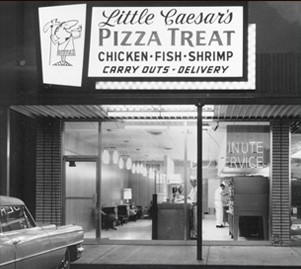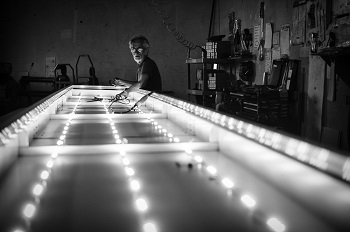
 Electra Sign was pleased to work again with Little Caesars and their latest location being opened in Swift Current Saskatchewan very soon. Little Caesars has a deep history that started way back in 1959 when husband and wife founders Mike and Marian Ilitch invested their life savings into their first pizza store (pictured left) in Garden City, Michigan, a suburb of Detroit. Since then Little Caesars has become the largest carryout-only pizza chain in the U.S. and an internationally known brand.
Electra Sign was pleased to work again with Little Caesars and their latest location being opened in Swift Current Saskatchewan very soon. Little Caesars has a deep history that started way back in 1959 when husband and wife founders Mike and Marian Ilitch invested their life savings into their first pizza store (pictured left) in Garden City, Michigan, a suburb of Detroit. Since then Little Caesars has become the largest carryout-only pizza chain in the U.S. and an internationally known brand.
Serving Western Canada with the brightest solutions, call the professionals at Electra Sign Ltd. Winnipeg today.
Little Caesars
1669-1150 Central Ave. N.
Swift Current, SK S9H 4C8
Kapil Sony – Owner (pictured below)


“I'm the owner of an established restaurant here in Winnipeg. I already have attractive signage that draws in business from the area so I’m not quite ready to update my current branding. Though the fluorescent lighting on my existing signs is outdated, and this creates various issues.
My outdated signage requires frequent maintenance, which can become exceedingly expensive. Another issue I have is that my fluorescent lighting is not energy efficient, nor is it environmentally friendly since I must frequently dispose of my used fluorescent lamps when I replace them. What can I do about this?”
 This is a common dilemma that many kinds of businesses face. Nowadays more and more people are asking this type of question as they want to save on maintenance and electrical costs and because they want to be more responsible, overall. Though it may not seem that way, the solution to this problem is actually very simple --and no, you don’t need to replace your sign altogether. You can convert your old signs’ outdated lighting system to LED's, which isn’t as costly as you would assume. Not to mention that having a new LED lighting system is a great investment with many additional benefits. Here are a few:
This is a common dilemma that many kinds of businesses face. Nowadays more and more people are asking this type of question as they want to save on maintenance and electrical costs and because they want to be more responsible, overall. Though it may not seem that way, the solution to this problem is actually very simple --and no, you don’t need to replace your sign altogether. You can convert your old signs’ outdated lighting system to LED's, which isn’t as costly as you would assume. Not to mention that having a new LED lighting system is a great investment with many additional benefits. Here are a few:
They are much brighter...
New LED systems are bright, offering the appearance of a new sign without the added cost. They make existing logos and graphics more vivid and eye-catching, which attracts more attention and thus, creating more potential customers.
They use less energy...
It’s common knowledge that LED's preserve energy better than traditional fluorescent and incandescent lighting. But how much more effective is it, really? LED’s can be up to 90% more efficient to run compared to traditional lighting. Over time, this will a save you lot of money.
They will need less servicing...
LED lights can last up to 100,000 hours. Compare that to traditional fluorescent lighting which typically only lasts from 7,000 to 15,000 hours and you’ll notice a major difference. A sign service crew of two men and a truck typically costs $150 per hour, with LEDs you’ll have to pay for their expensive services significantly less often.
Electra Sign recognizes the importance of signs as an investment for your business. If we can help you prolong that investment, please feel free to reach out to us for an estimate.

Electra Sign Ltd. was pleased to work with d3h Hotels Inc. on the Home Inn & Suites project located in Swift Current SK. The striking new signs are internally illuminated by energy efficient LED’s creating a small ECO friendly foot print for there newset hotel.
Customer Profile: Based in Saskatoon, d3h Hotels is a hotel management company that owns and operates nine hotels across Western Canada with its two new and upcoming builds of Home Inn & Suites in Swift Current and Yorkton starting in the fall of 2011.
Over the past 13 years, d3h Hotels has gained extensive knowledge and experience in the design and construction of hotels. The company recently celebrated its 10th build, pushing this young management company to retain the honour of being the largest franchisee of Days Inns in Canada.
Saskatchewan’s “best kept secret” not only builds, owns and manages hotels but also franchises the Home brand to potential hoteliers. The HomeSuites and Home Inn & Suites franchise offers hassle-free, turnkey solutions that will allow the franchisee to focus on running a profitable business from day one
d3h’s vision is to ‘work together as a team to provide customers with “stay experience” that makes them feel they were at home’.
d3h Hotels Inc.
1139 – 8th Street East
Saskatoon, SK
www.d3h.ca
Branding & Awareness through effective signage. We are here to help at Electra Sign Ltd. Winnipeg Manitoba.
To directly speak with a representative, call:
Winnipeg204.452.6168